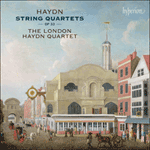
Welcome to Hyperion Records, a British classical label devoted to presenting high-quality recordings of music of all styles and from all periods from the twelfth century to the twenty-first.
Hyperion offers both CDs, and downloads in a number of formats. The site is also available in several languages.
Please use the dropdown buttons to set your preferred options, or use the checkbox to accept the defaults.

| The London Haydn Quartet» More |
The jewel of the quartet is the rapt E flat major Largo, with its soaring violin cantilena and gorgeous remote modulations. More than any other slow movement in Op 33, the music looks ahead fifteen years to the profound meditations in Haydn’s Op 76 quartets. Sentiment is gleefully banished in the finale, a whirlwind rondo that varies its catchy contredanse theme on each return. In the second episode, in G minor, Haydn mines his favourite Hungarian gypsy vein, as he had done in the ‘Bird’. Again the movement disintegrates into slapstick. After a distended, spidery version of the theme and a failed attempt to ‘normalize’ it, Haydn cuts his losses and exits with an absurd simplification of the tune, played pizzicato. Back in the 1760s, po-faced critics from Berlin and Hamburg had taken Haydn to task for ‘debasing the art with comic fooling’. Two decades later he was still at it.
from notes by Richard Wigmore © 2013
Le joyau de ce quatuor est le profond Largo en mi bémol majeur, avec sa cantilène de violon qui s’élève vers les cieux et ses superbes modulations infimes. Plus que tout autre mouvement lent de l’op. 33, la musique anticipe de quinze ans les profondes méditations des quatuors, op. 76, de Haydn. Tout sentiment est joyeusement banni dans le finale, un rondo tourbillonnant qui varie son thème entraînant de contredanse à chaque retour. Dans le deuxième épisode, en sol mineur, Haydn exploite sa veine tzigane hongroise préférée, comme il l’avait fait dans «L’Oiseau». Une fois encore, le mouvement se transforme en une bouffonnerie. Après une version arachnéenne et distendue du thème et une tentative ratée de «normalisation», Haydn arrête les frais et trouve une porte de sortie avec une simplification absurde de la mélodie, jouée pizzicato. Dans les années 1760, des critiques berlinois et hambourgeois à l’air pincé avaient reproché à Haydn d’«appauvrir l’art avec des idioties comiques». Une vingtaine d’années plus tard, il campait toujours sur ses positions.
extrait des notes rédigées par Richard Wigmore © 2013
Français: Marie-Stella Pâris
Das Juwel des Quartetts ist das verzückte Largo in Es-Dur mit seiner emporsteigenden Geigenkantilene und wunderschönen Modulationen in abgelegenen Regionen. Mehr noch als die anderen langsamen Sätze in op. 33 blickt diese Musik voraus zu den tiefgründigen Meditationen der Quartette op. 76, die 15 Jahre später entstehen sollten. Im Finale sind tiefe Empfindungen verbannt; es erklingt ein fröhliches, wirbelwindartiges Rondo, dessen eingängiges Kontretanz-Thema bei jedem Auftreten variiert wird. In der zweiten Episode in g-Moll bedient sich Haydn wieder des von ihm bevorzugten Zigeunerstils, wie er es auch im „Vogelquartett“ getan hatte. Auch hier geht der Satz schließlich in eine Slapstick-Komödie über. Nach einer ausgedehnten, spinnenartigen Version des Themas und einem gescheiterten Versuch, es zu „normalisieren“, setzt Haydn der Sache ein Ende und schließt mit einer absurden Vereinfachung der Melodie im Pizzicato. Bereits in den 1760er Jahren war Haydn von besonders scharfen Kritikern in Berlin und Hamburg ob seiner „Herabwürdigung der Musik zu komischen Tändeleyen“ getadelt worden. Zwanzig Jahre später war Haydn allerdings immer noch zu ähnlichen Scherzen aufgelegt.
aus dem Begleittext von Richard Wigmore © 2013
Deutsch: Viola Scheffel
 Haydn: String Quartets Op 33 Haydn: String Quartets Op 33The London Haydn Quartet perform Haydn’s popular Op 33 quartets on period instruments. The set is beautifully recorded and competitively priced.» More |

